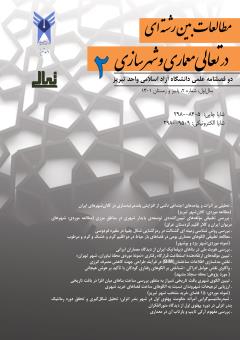مطالعه تطبیقی الگوهای معماری بومی در فضاهای باز حیاط در دو اقلیم گرم و خشک و گرم و مرطوب(نمونه موردی:شهر یزد و بوشهر)
محورهای موضوعی : معماری
مقدی خدابخشیان
1
![]() ,
مرجان سعیدنیا
2
,
مرجان سعیدنیا
2
1 - استادیار گروه معماری، واحد اصفهان(خوراسگان)، دانشگاه آزاد اسلامی، اصفهان، ایران. (نویسنده مسئول) Meg.kh@khuisf.ac.it
2 - کارشناس ارشد معماری، گروه معماری، واحد اصفهان(خوراسگان)، دانشگاه آزاد اسلامی، اصفهان ،ایران.
کلید واژه: ", معماری بومی", , ", معماری همساز با اقلیم", اقلیم گرم و مرطوب", اقلیم گرم و خشک", فضای باز", , ", حیاط",
چکیده مقاله :
یکی از عناصر بنیادی معماری بومی، فضاهای باز یا حیاط می باشدکه در اقلیم های گوناگون با شکل های مختلف قابل مشاهده است. در این مقاله به بررسی الگوهای بومی فضاهای باز حیاط در دو اقلیم گرم و مرطوب و گرم وخشک در دو شهر یزد و بوشهر پرداخته شده است. روش تحقیق اتخاذ شده در این نوشتار، روش تحقیق کیفی تطبیقی است که با بررسی مستندات کتابخانه ای مربوط به اصول اقلیمی هر منطقه به تطبیق اطلاعات به دست آمده از طریق مشاهدات میدانی مربوط به 4 نمونه ی خانه ی دوره قاجار در هرکدام از شهرها پرداخته شده است. پژوهش حاضر درصدد پاسخگویی به این پرسش است که" عملکرد اقلیمی حیاط در دو اقلیم گرم و خشک و گرم و مرطوب چگونه است؟". جهت رسیدن به پاسخ؛ شکل ، تناسبات ،هندسه و خصوصیات کالبدی بدنه های مرتبط با حیاط در نمونه های مورد مطالعه مورد ارزیابی قرار گرفت. یافته ها نشان داد که در تناسبات حیاط های خانه های بوشهر، مولفه ارتفاعی دارای بیشترین مقدار، نسبت به مولفه های افقی طول و عرض کف حیاط بوده است و حیاط به حالت مکعب مستطیل ایستاده می باشد در حالی که در خانه های یزد مولفه ارتفاعی نسبت به مولفه های افقی طول و عرض کف حیاط دارای میران کمتری است و حیاط در این شهر حالت مکعب مستطیل خوابیده دارد. فرم مکعب مستطیل ایستاده در بوشهر جهت ایجاد تهویه عمودی و به جریان درآوردن رطوبت منطقه به صورت دودکشی عمل می نماید در حالی که در یزد فرم خوابیده حیاط امکان ایجاد تهویه عرضی را مهیا نموده و افزایش رطوبت از طریق استفاده از حوض و پوشش گیاهی در سطح وسیع ترنسبت به شهر بوشهر را امکان پذیر نموده است.
The concept of vernacular architecture for humans has always been subject to climatic conditions if health and comfort were of concern. For this purpose, it is necessary to assess the constitutive component thereof. One of the basic components of vernacular architecture is the open spaces or courtyards with different dimensions subject to the climatic conditions of the reign. The rational spatial orientation of these spaces determines the architectural nature of vernacular structures and highly contributes to the axiomatic aspect and the identity of such structures. The existing general patterns of these spaces are assessed in two, hot and humid, and arid climates in the two cities of Yazd, located in central, and Bushehr, located in the south-west regions of Iran. In each city, four structures of the Qajar era (1796-1925) constitute the subjects of this article. The subject structures belonged to the wealthy and elite, where the courtyard was located in the middle of summer and winter dwellings. The method adopted in this article is comparative-qualitative. An attempt is made to compare the findings of the subject structures through field observations and library documentation. The objective is to answer the following this question : " How is the climatic performance of the yard in two arid climate and hot and humid climates ? " . In general, the findings indicate that the shape and dimensions of each courtyard are proportionally subject to the geometry and physical characteristics of the entire structure. As to the proportion of the structure height, Vertical component to the dimensional horizental components of the courtyard in Bushehr, with an average depth-to-height ratio of Z at 1.24 is evident, indicating a standing position . Consequently, the airflow in the courtyard follows a circular pattern, something essential for this unique climate in providing natural vertical ventilation. This phenomenon is reversed in Yazd where the airflow follows a flat pattern, with an average depth-to-height ratio of Z at 0.51 is evident, something essential for this unique climate in providing natural horizontal ventilation. In both climates, the courtyard orientation is N-S to control temperature rise with an average of 16% and 29% of the entire structure area, respectively. It is found that in Yazd the existence of a water pond area with a 73 m2 average and a vegetation area at 56 m2 in the courtyard provide the required humidity for the area. The courtyards in Bushehr are covered with less vegetation with an average area of 5 m2, and the existence of a water pond there is an almost new phenomenon with an average area of 7 m2 because in the traditional architectural plans water pond non- existence. The courtyard area in Bushehr is square with an average of length to width ratio1.07 and smaller than the rectangular courtyards of Yazd with an average of length to width ratio1.43. Therefore, the yard has also had a climatic approach in both cities. The findings of such studies can contribute to the planning and construction of modern buildings with vernacular architecture if necessary.
_||_


